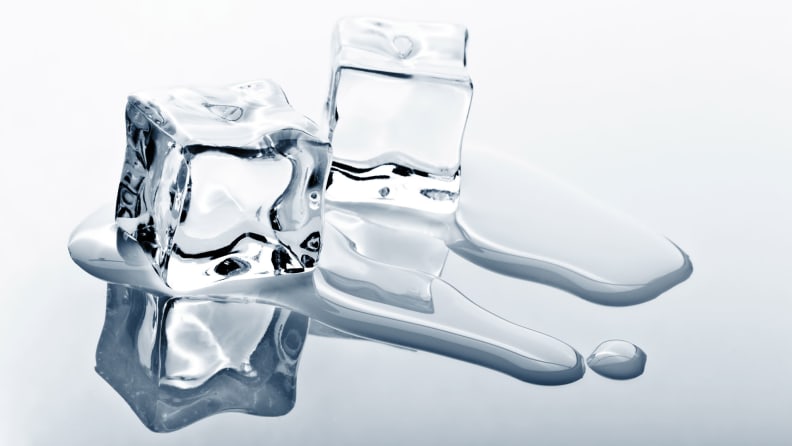Products are chosen independently by our editors. Purchases made through our links may earn us a commission.
When it comes to ice, most of us still use the plastic ice cube trays that came with our refrigerator, without really thinking about it. Or, maybe you have a fridge that features a built-in ice-maker.
More and more, however, these simpler, and perhaps dated, methods of making ice are being replaced with modern tech. Newer appliances have begin experimenting with different types of ice beyond just crushed and cubed.
Follow us as we dive into the chilly world of ice-making to figure out the best ways to create it for your personal use.
Sometimes, you need a lot of ice, quickly
If you’re the go-to host of your friend group, occasions likely arise where you need a lot of ice, fast: game-day gatherings, backyard barbecues, and the like. Ice cube trays and other traditional means of making ice often can't replenish your reserves fast enough, and buying supplemental bags ice beforehand can get pricy over time.
Many modern refrigerators come with built-in ice-makers, but those are often comically slow. One fridge we had in for testing could only make 8 cubes in 90 minutes.
On the other hand, Bosch's 2020 fridges feature the QuickIcePro System, which leverages new tech to produce up to 12 pounds of ice per day—a rate of about a half-pound per hour. Assuming you start with a full compartment of ice, this rate of replenishment should keep even the thirstiest party guests supplied with cold cubes.
We're excited to get this model in for testing, because that throughput would make it one of the best built-in ice-makers to date.
If you aren't in the market for a new fridge at the moment, a dedicated ice maker may be a good option for you. More industrial ones are pretty expensive, but they can produce hundreds of pounds of ice per day—probably overkill for your needs.
Countertop ice makers are still pretty expensive, but they can typically make between 20 and 30 pounds of ice per day and often pride themselves on how quickly they can produce a batch of ice. Typically a batch consists of roughly 10 cubes, and can be ready in about as many minutes.
Shaped ice: Are spheres supreme?
When it comes to ice, shape is important because it dictates its overall surface area. The higher the surface area of the ice, the faster it will melt.
This means ice cubes with higher surface areas, like most novelty-shaped ices, melt pretty quickly. This gets a drink to a colder temperature faster, but it also dilutes it.
Spherical ice, on the other hand, has the lowest surface area possible, which means less extreme cooling for longer periods of time. Nobody likes a watered-down cocktail, which is why spherical ice is so popular at craft cocktail bars and with connoisseurs.
One of LG's newer fridges makes spherical ice. Not only do these cold globes look trendy, they're also just better at being ice than the traditional trapezoidal prism from an ice cube tray that you're used to.
There are also some countertop ice-makers that specialize in making spherical ice, but those aren't made for a particularly high throughput. You'll often only get a few spheres per cycle.
There are also spherical ice molds, which are cheaper, but tend to take longer than dedicated ice-makers.
Clear ice

Clear ice will melt slower and taste better than its cloudy counterpart—and it's also pretty easy to make.
If you haven't heard the term before, clear ice refers to a mostly an aesthetic preference for ice cubes, but there are also a few practical reasons for why it's better. When ice is cloudy, it may be due to impurities in the water, gas bubbles, uneven freezing, or some combination of all these factors.
Impurities are one of the factors that can affect the flavor of your drink, which is why it's a good idea to use filtered water when making ice cubes. Gas bubbles are less of an issue, but since they increase the surface area of your ice and speed up its melting, they may not be desired.
While there's tech on the horizon that will have your fridge making ice more quickly or in unique shapes, the ability to produce clear ice still hasn't made its way to major appliances. We haven't seen anything forthcoming.
There's a lot of tutorials online for how to make your own clear ice, but many have superfluous steps. All you really need is a small cooler that can fit into your freezer. Simply fill it with warm water and pop it in your freezer for a full day.
This method allows ice to form slowly, from the top down, resulting in a large chunk of clear ice. You can then cut it into desired shapes with a serrated knife and mallet.
If you want less of a DIY experience when it comes to clear ice, there are products out there that can make clear ice for you—and they tend to vary pretty greatly in terms of price. Some less expensive options work well enough, but take about a day to make a handful of clear cubes. More expensive options can produce clear ice a bit faster and in higher quantities. But these are also more expensive.
Stay cool!
Now that you're armed with all these products and tips, it's time to up your ice game. Maybe it's finally time to narrow down why your ice cubes taste funny, reduce your wrinkles (maybe?), learn how to defrost your freezer, keep your iced coffee from watering down, or strap on your fanciest ice vest.
The product experts at Reviewed have all your shopping needs covered. Follow Reviewed on Facebook, Twitter, and Instagram for the latest deals, product reviews, and more.
Prices were accurate at the time this article was published but may change over time.


